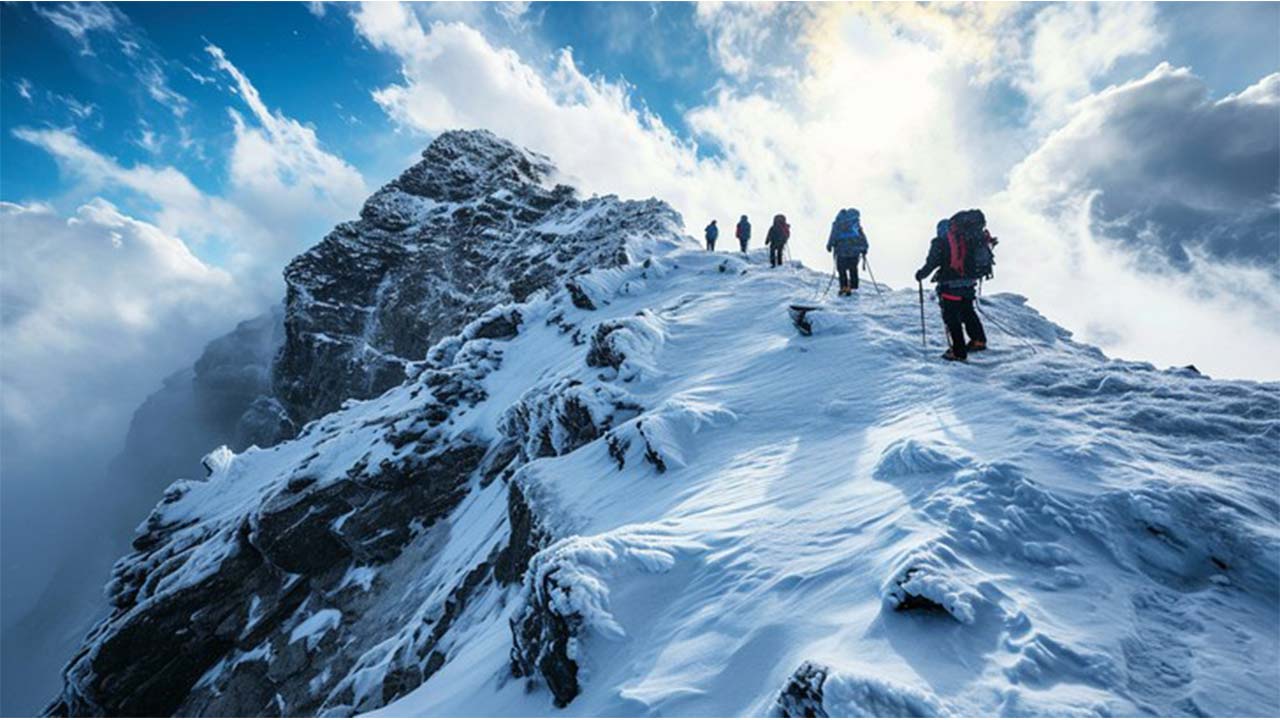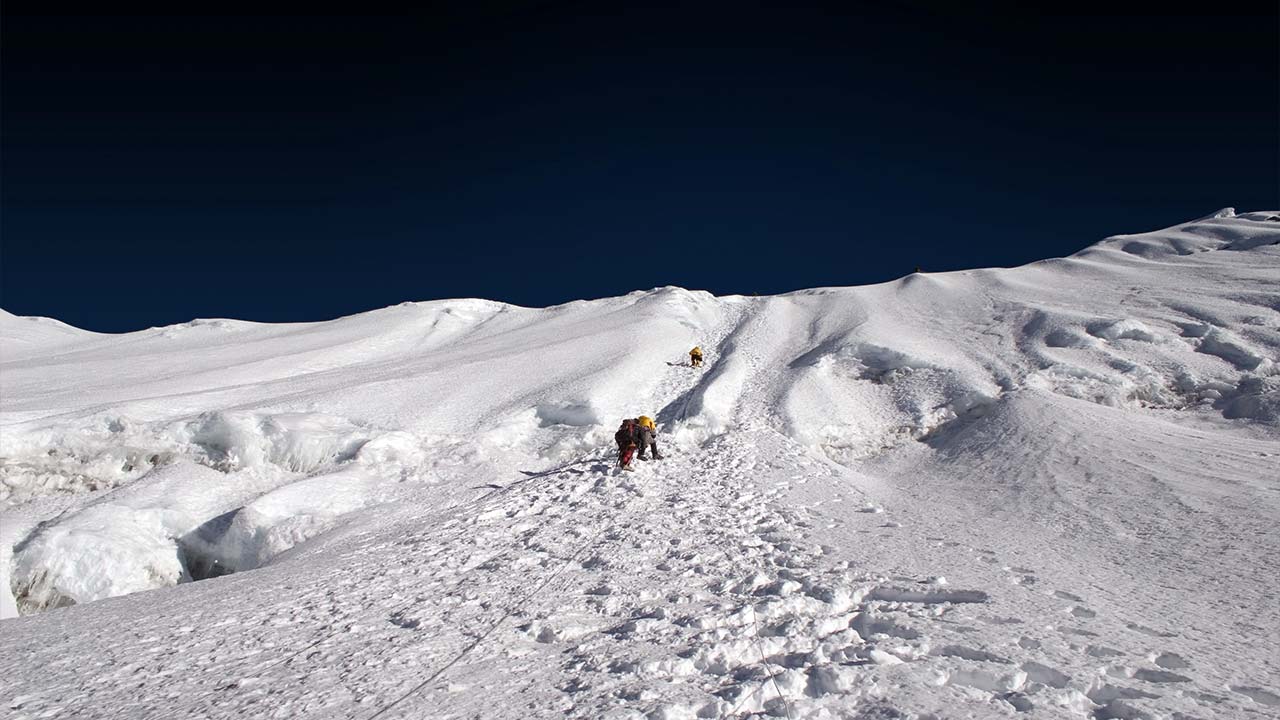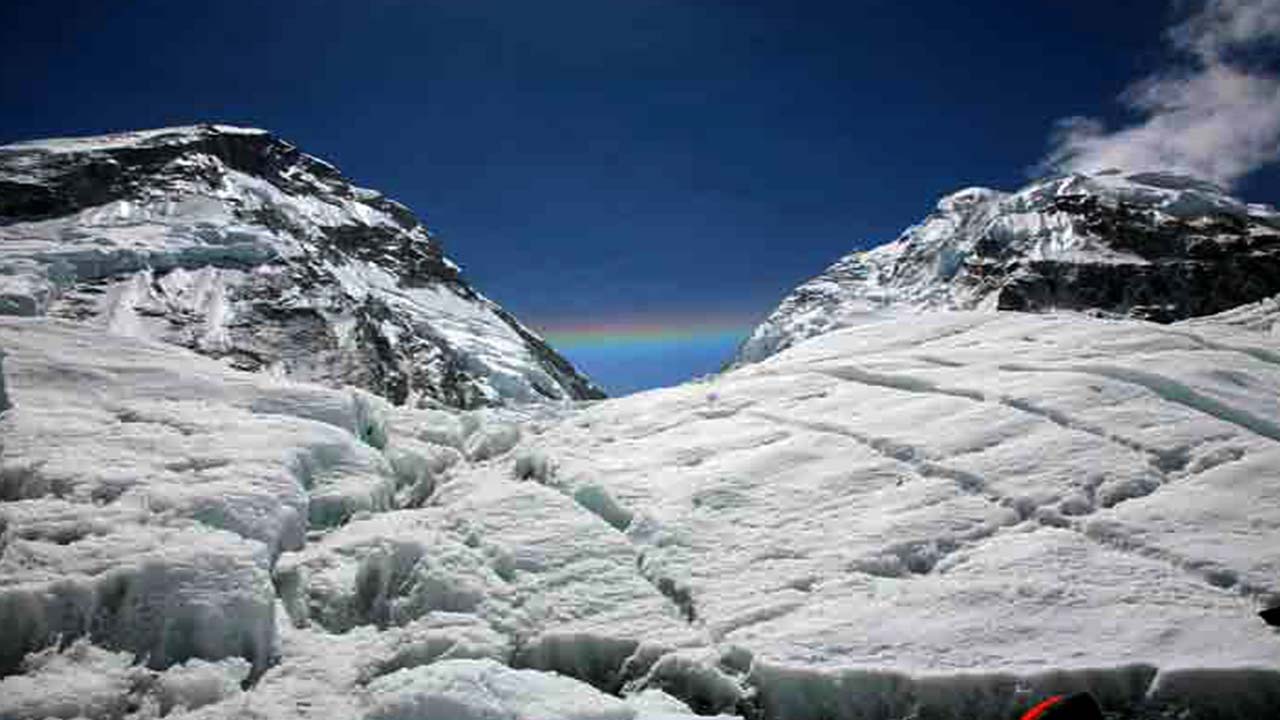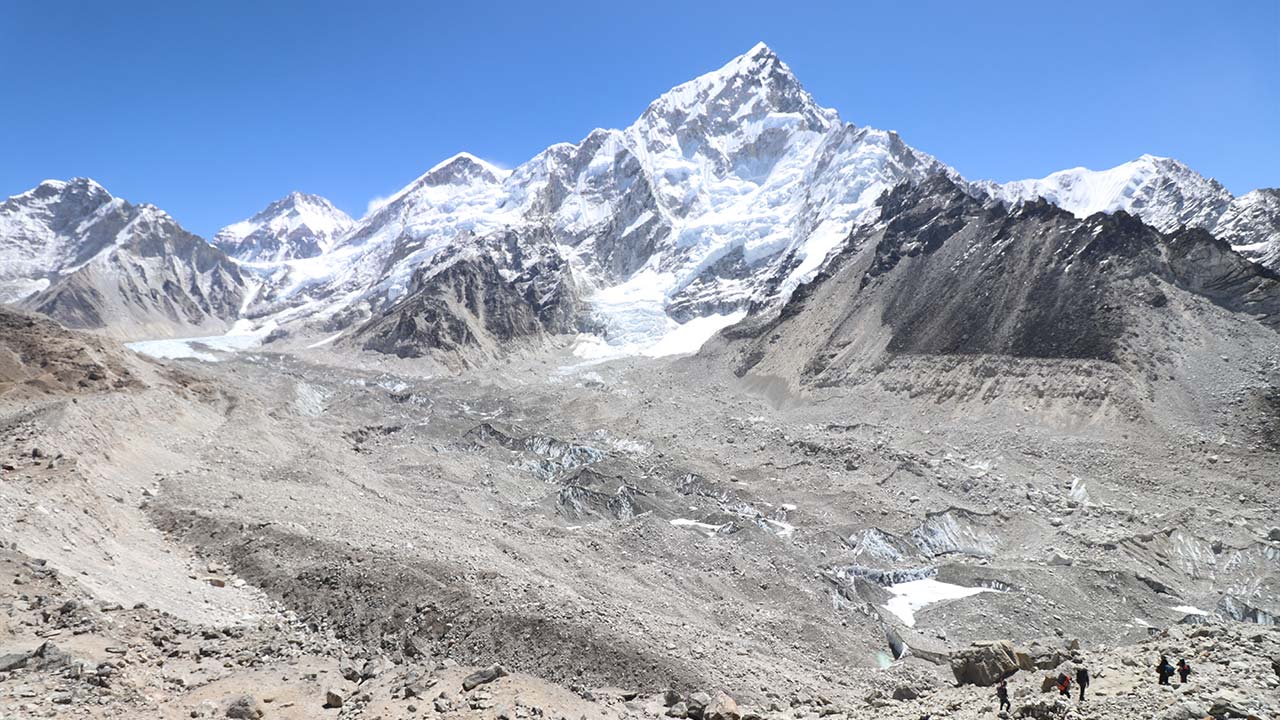Mount Everest, at an elevation of 8,848 meters (29,031 feet), has long represented the pinnacle of human ambition in mountaineering. However, beneath its celebration summit lies a lesser-known somber region known as Everest Rainbow Valley. It is a name that evokes beauty but conceals a deep, dark and far more tragic reality.
The Mt Everest Rainbow Valley refers to a particular section on the northeast ridge of the world’s tallest peak, approximately above 8,000 meters (26,246ft) from sea level, where numerous climbers have perished in snow during their attempt to reach or descend from Everest’s summit.
The vibrant jackets and gear worn by the fallen climbers create a distinct visual contrast against the white snow and grey rock, giving rise to the name ‘The Rainbow Valley’, which feels strangely poetic yet is deeply tragic in reality. This valley up high in the clouds is not accessible to trekkers and is only seen by the summit climbers traversing the Everest Death Zone.
In the sections ahead, we will explore the origins and meaning of Rainbow Valley Everest and clarify its location, addressing the ethical, logistical and emotional complexities surrounding it. This article will shed light on one of Everest’s most sobering realities.

What is Rainbow Valley Everest?
What is Rainbow Valley Everest? It is a particular haunting section of Mount Everest located just below the summit on the northern side of the mountain. This segment lies within the famous Everest Death Zone and is above the altitude of 8,000 meters (26,246ft). At this level, the oxygen level is less than one-third of what it is at sea level.
The Rainbow Valley is not a literal valley, but it's a morbid nickname given to the slope inside the death zone where the bodies of the fallen climbers remain scattered and frozen. Many of the fallen climbers on the snow are dressed in brightly colored down suits, which gave the area its ironically beautiful name, but with a much darker truth.
The Rainbow Valley Everest symbolizes a vivid spectrum of reds, yellows, greens and blues from these insulated suits, which stand starkly against the barren and icy terrain. Tragically, many climbers who perish on their final push to the summit are left where they fall. Recovering bodies at such altitude is often impossible, too dangerous and prohibitively expensive.
Over time, the accumulation of these brightly dressed bodies scattered along the steep incline created a multicolored landscape, thus the name Rainbow Valley. The name given to this particular section inside the death zone of Everest, however, carries an unsettling duality.
On one hand, the given name evokes the image of beauty and wonder to those who are not familiar with the backstory. And, on the other hand, it masks the brutal reality of life and death situations on the world’s highest peak. There is a misconception about the Everest Rainbow Valley, as many believe it is an actual lush valley or colorful gorge near the base camp, but it is false.
The Rainbow Valley is not visible to the trekkers and doesn’t lie along the traditional trekking routes. It is only encountered by summit climbers typically on the northeast ridge while climbing from the Tibetan side. The symbolic weight of Mt Everest Rainbow Valley runs deep in the mountaineering world. It is a palace of mourning, remembrance and ethical reflection.

Where is Rainbow Valley on Everest?
If you are curious about this chillingly named section and where is Rainbow Valley on Everest exactly, it lies near the summit of the world’s highest mountain. It is not on the popular southern route from Nepal, but on the northeast ridge along the Tibetan side to the summit. The Rainbow Valley Everest is perched at a staggering altitude of around 8,000 meters (26,256 feet).
This valley falls within the Death Zone, a place where the oxygen level is so low that the human body starts to gradually die, cell by cell. It is beneath the icy sky near the summit where the slope of frozen tragedy stretches that climbers need to pass through. In this steep and treacherous section of Everest’s upper slope, the brightly colored climbing suits of red, green, blue and orange have remained vividly preserved in the bitter cold.
Thus, creating a landscape that is haunting and surreal at once. To the passerby, these colors scattered across the desolate ridge resemble a rainbow, contrasting starkly against the white snow. Thus, the name was born, Everest Rainbow Valley, beautiful in name but brutal in meaning.
Most people who ask Where is Rainbow Valley on Everest? Assume that it lies somewhere along the famous Everest Base Camp trail in Nepal. But that is far from the truth, the trekkers hiking to base camp on the southern face never come close to this location. In fact, even mountaineers who take the South Col route, taken by the majority of climbers ascending from Nepal, follow the southeast ridge.
So, even then, it is a completely different face of the mountain, on the opposite side from the actual Mt Everest Rainbow Valley. While the South Col side has its own landmarks such as Hillary Step and the Balcony, the Rainbow Valleys lie on the broader approach. This route is used by climbers ascending from the Tibetan side via the Rongbuk Glacier and Advanced Base Camp.
It is important to understand that this section on the mountain is only seen by those who are making the final summit push from the north side. Rainbow Valley is not visible to trekkers, not accessible from the South Col and is not a destination that anyone sets out to reach.
The Rainbow Valley: Name, Irony and Visuals
There are only a few places on earth that carry a name with haunting contrast, such as the Mt Everest Rainbow Valley. The name evokes something gentle, like a serene landscape painted in color, maybe a dreamlike destination beneath the open sky. But, in the case of Mount Everest, that name comes with an unbearable weight. The Rainbow Valley Everest is not a peaceful or serene meadow; it is, in fact, a slope of sorrow and silence.
Lying just below the summit of the northeast ridge of Everest, this is a frozen graveyard where climbers who never made it back remain and their brightly colored suits remain frozen in time on the mountain slopes.
The name Everest Rainbow Valley was never a part of the official mountaineering terminology. It arose from the chilling visual that greets the climbers pushing for the top of the world. A slope of scattered bodies of climbers, many of them still dressed in their vibrant expedition gear of red, blue, green, orange and yellow, which have become permanent fixtures in the ice and rock.
But what makes the Rainbow Valley Everest so unsettling is the irony behind its name. These scattered colors of the down suits of the fallen climbers scattered on the slopes are not the symbol of celebration or peace. They are the silent reminders of the climbers who fell from exhaustion, altitude sickness, frostbite, or accident while chasing their dreams.
Each bright spot in this colorful segment of the mountain represents a life, a story and a dream that ended high above the clouds. For the climbers taking the northeast ridge, this patchwork on the mountain is not just a visual memory but an emotional reckoning. It reminds the climbers of the razor-thin line between success and death inside the Everest death zone.
What the climbers witness is not dramatic in the cinematic sense. There are no signs, no monument, no final messages, just an open, windswept slope with scattered figures frozen in time. Some of the bodies of these fallen climbers are partly covered, while others are exposed, all quietly woven into the mountain.
There is no chaos in this part of the mountain, no noise, just stillness and color. The real Rainbow Valley is not a colorful place of dreams; it is a quieter and sobering graveyard in the sky that demands reverence, not curiosity.

Why Are Bodies Left Behind in Everest Rainbow Valley?
This question is often asked, sometimes out of genuine curiosity, while other times out of disbelief, why are bodies left behind in Everest Rainbow Valley? Well, the answer, although painful lies in the brutal nature of high-altitude mountaineering, the limitation of human endurance and the cruel indifference of the world above 8,000 meters.
The death inside the Everest death zone is not an anomaly; it is a known risk that every mountaineer chasing their dream on the slope is familiar with. Once it happens, recovery is a near-impossible task. In the part of the mountain where oxygen level is one-third of what it is at sea level, every step of the climber becomes a battle.
Here, judgment fades, body deteriorates rapidly and every second counts. So, in this zone where carrying your own weight becomes a massive challenge, let alone the weight of carrying another body. Retrieving a deceased climber from such an altitude is not just physically exhausting, but it can also often be lethal.
Even with the help of elite Sherpas and supplemental oxygen, a body can weigh over 150 kg (330 lbs) due to frozen gear and rigor mortis. Thus, moving such weight across the narrow ridges, vertical ice walls and deep crevasses is not technically dangerous, but sometimes it is not possible at all.
While trying to retrieve Everest dead bodies at such an altitude, the crew risks losing their own lives in the process. As a result, the expedition leaders, their families and surviving teammates make the agonizing decision of leaving them behind; they remain where they fall, like a sea burial tradition of the sailors.
The cost factor for retrieving the body is also very expensive. General body recovery mission on Everest can range from US$ 30,000 to US$ 70,000 and even more, depending on the altitude, weather and route conditions. For the rescue operation from the Everest death zone, the cost can be insanely high.
For such operations, it is necessary to mobilize a specialized rescue team with a high-altitude helicopter access and a wide range of technical tools. Many families that are already emotionally devastated and financially burdened from the cost of the climb cannot bear this additional strain.
Among the many names etched into Everest’s unforgiving heights, stories like Everest Green Boots and Francys Arsentiev- Everest Sleeping Beauty are well-known landmarks along the northeast climbing route. Over time, these figures became more than individuals; they became the cautionary symbols for those chasing their dreams to the top of the world.
So, the bodies remain on the slope of the mountain, not out of neglect but out of the sobering truth that in the highest reaches of the world, even death must be endured with practicality. The Rainbow Valley Everest is not a cemetery by design, but it has become one out of necessity, a silent and unforgiving grave marked by the colors of the rainbow.

The Death Zone and Rainbow Valley
To understand why so many lives end in the Everest Rainbow Valley, we first need to understand the terrifying concept known as the Everest Death Zone. This term refers to any altitude above 8,000 meters (26,256 feet) where the oxygen level is so low that the human body begins to deteriorate the moment it enters the zone.
Inside the Everest's Death Zone, the oxygen level drops to just one-third of what they are at sea level. So, at this elevation, every breath feels shallow, muscles lose strength and mental clarity begins to fade. Inside the Everest Death Zone body can no longer properly metabolize food, repair tissues, or fight off the cold.
Even with the supplemental oxygen, climbers are essentially dying in degrees inside the death zone. The longer one remains in this zone, the slimmer the chance of survival becomes. In fact, there is a 2 o’clock rule in Everest. This is a critical safety guideline that dictates that the climber must reach the summit of the peak by 2:00 PM.
If they are not at the top of the mountain, climbers need to descend immediately, regardless of how close they are to the summit. This is an iron-clad rule that climbers must abide by. Inside the death zone, weather conditions can deteriorate rapidly. Climbers need to account for daylight hours, limited hydration and supplemental oxygen.
Now, imagine the Rainbow Valley Everest is located deep within the death zone and just below the summit along the northeast ridge. That makes it one of the deadliest stretches of the mountain. It is not a valley in the traditional geographic sense, but a term climbers use to describe a steep slope that is scattered with brightly colored suits of the fallen climbers.
The location of Everest Rainbow Valley is no coincidence. It is directly on the final push to the summit, a stretch where the climbers are exhausted, oxygen-deprived and dangerously close to their physical and psychological limits. The Everest Death Zone is also the segment on the mountain where the summit fever takes hold.
Many climbers push themselves beyond reason and beyond safety, hoping to taste the glory of standing at the top of the world. And, many collapse on the way up or the way down. In such a state, even a minor problem becomes life-threatening. Inside Everest’s Death Zone, there is no margin for error and no real rescue, you are pretty much on your own and so is everyone else.

